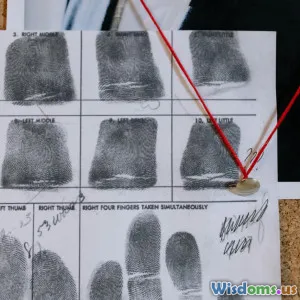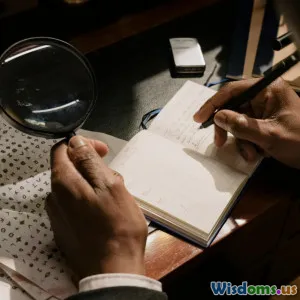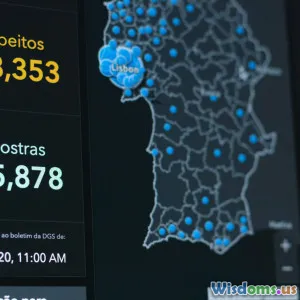
The Evolution of Crime Scene Investigation Methods
9 min read Explore the transformation of crime scene investigation methods throughout history. (0 Reviews)
The Evolution of Crime Scene Investigation Methods
Crime scene investigation (CSI) is a sophisticated field that has undergone tremendous transformation over the past century. Initially, methodologies were rudimentary, often reliant on the basic principles of observation and deduction. However, with the advancement of technology and forensic science, the landscape of crime scene investigation has drastically shifted. This article delves into the historical evolution of CSI methods, the introduction of critical technologies, and future trends in this vital field of criminology.
The Beginnings: Early Investigative Methods
In the late 19th and early 20th centuries, crime scene investigation was primarily an extension of detective work. Methods were not standardized; investigators were often self-taught and relied on experience, intuition, and rudimentary principles of logic. Early techniques included:
- Observational Skills: Detectives closely observed crime scenes, but were often reliant on personal experience.
- Interview Techniques: Gathering testimonies from witnesses and suspects was conducted without any formal structure.
- Physical Evidence: The collection of physical evidence was haphazard; basic practices of collecting fingerprints or shoe prints were employed, but with little understanding of the science behind it.
For instance, the 8th-century Persian physician Avicenna was known for detailing case studies that involved symptoms, behavior, and the potential motives of suspects. Considering a small area in Birmingham, the famous case in 1888 of the Jack the Ripper murders highlighted the lack of coordination in crime scene processes—physical evidence was left untouched and leads were poorly managed.
The Institutionalization of Forensics
The early to mid-20th century bore witness to a more systematic approach to crime scene investigation. The establishment of forensic science as a distinct discipline started with the formal training of officers and the introduction of units responsible for evidence processing. Notable developments included:
- Fingerprinting: Sir Francis Galton's work paved the way for using fingerprinting as a tool for identification.
- Ballistics: With the invention of firearms, the study of bullet trajectories and gunshot residues began to gain attention.
- Blood Typing and Serology: Not until the 20th century did the use of blood evidence come to the forefront. Techniques developed subsequently laid groundwork for DNA analysis.
A perfect example of these evolving techniques was the 1932 Bruno Hauptmann trial, which was one of the first major American cases to highlight these forensic tools. Investigators used fibers, footprints, and wood analysis, setting higher standards for crime scene protocols.
The Modern Era: Advancements in Science and Technology
As forensic science progressed into the late 20th and early 21st century, technology played an unprecedented role in enhancing the capabilities of crime scene investigations. Highlights of this period include:
- DNA Analysis: Introduced in the late 1980s, methods such as PCR (Polymerase Chain Reaction) revolutionized criminal investigations by allowing the identification of suspects based on genetic information extracted from crime scenes.
- Digital Forensics: In the age of the internet, digital forensics has become a cornerstone of modern crime investigations, addressing crimes that involve computers and digital storage systems. An example would be the use of cloud computing data during investigations.
- Enhanced Evidence Collection Techniques: With tools such as Luminol for blood detection and advancements in ballistic analysis like Integrated Ballistic Identification Systems (IBIS), the accuracy in gathering and analyzing evidence has skyrocketed.
One highlighted case is the O.J. Simpson trial (1995) where DNA evidence became central to the outcome, demonstrating how modern forensic techniques can determine guilt or innocence.
Crime Scene Investigation Protocols Today
Now, contemporary crime scene investigations follow strict protocols that reflect the best of what modern investigative practices and technologies can offer. These include:
- Crime Scene Protection: Securing the scene is essential to prevent contamination. Various levels of law enforcement personnel, including specialized units, are trained to preserve a scene without altering evidence.
- Methodical Evidence Collection: Investigators utilize a standard method known as the Triage process — surveying the scene, documenting everything through photography, sketching, and meticulous note-taking, all ensuring that every piece of evidence can lead to a conclusive orientation.
- Specialized Investigation Units: Law enforcement now employs behavioral analysts, biologists, and crime scene technicians—trained specifically to analyze different types of evidence, improving the investigation's accuracy.
Challenges in Crime Scene Investigation
Despite advancements, crime scene investigation is faced with new challenges that arise from changing technology and social behavior. Some key challenges include:
- Cybercrime: The growing frequency of cyber-related crimes, which require not only traditional investigation skills but also knowledge of technology.
- Data Overload: With the vast quantity of evidence that can now be collected, analyzing and prioritizing data becomes a daunting task. For instance, the number of mobile devices found at a scene can incorporate countless digital trails.
- Ethical Considerations: The application of forensic evidence must be handled with care to ensure ethical practices and the protection of civil liberties.
An intriguing case that encapsulates these challenges was the Golden State Killer investigation, which linked decades of unresolved case evidence to pending genetic databases, inspiring significant discussions around privacy laws.
Future Directions: What's Next for Crime Scene Investigation?
Looking ahead, the landscape of crime scene investigation methods is expected to evolve further:
- Artificial Intelligence (AI): With the growth of AI technology, agencies are already exploring AI applications for predictive policing, crime scene reconstruction, and automated evidence sorting.
- Improved Forensic Techniques: As fields like DNA analysis continue to innovate (e.g., using Next-Generation Sequencing technologies), there will be ongoing enhancements in how evidence can be evaluated.
- Training and Resources: Emphasizing the necessity of continuous education for police and forensic specialists to stay updated on emerging technologies and investigative techniques.
Conclusion: The Continuing Transformation of Crime Scene Investigations
The evolution of crime scene investigation methods has been profound, transitioning from an inexact art based on personal judgment to a high-tech, scientifically-backed field. With improving tools and technologies, law enforcement agencies are better equipped than ever to solve crimes and secure convictions. As we continue to see advancements, it’s critical to stay abreast of these changes and their implications for society. In doing so, not only do investigators become more efficient in solving cases, but they also uphold the justice that society demands. In an age where every piece of evidence can make a difference, both components in crime scene investigation—the traditional elements of inquiry and modern technological innovations—will shape policing well into the future.
Rate the Post
User Reviews
Popular Posts





















